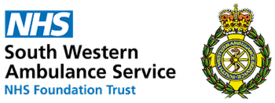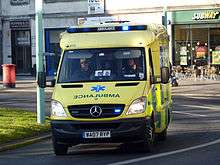South Western Ambulance Service
The South Western Ambulance Service NHS Foundation Trust (SWASFT) is the organisation responsible for providing ambulance services for the National Health Service (NHS) across South West England (the counties and unitary authorities of Bristol, Bath and North East Somerset, Cornwall, Devon, Dorset, Gloucestershire, North Somerset, the Isles of Scilly, Somerset, South Gloucestershire and Wiltshire).[3] On 1 March 2011, SWASFT was the first ambulance service in the country to become a NHS foundation trust. On 1 February 2013, neighbouring Great Western Ambulance Service merged with the trust.[4]
| South Western Ambulance Service NHS Foundation Trust | |
|---|---|
| SWASFT | |
 The NHS corporate identity logo of South Western Ambulance Service Foundation Trust | |
 Regions served by South Western Ambulance Service | |
| Type | NHS foundation trust |
| Established | 1 July 2006 (Cornwall, Devon, Dorset and Somerset) 1 February 2013 (merged with Great Western Ambulance Service) |
| Headquarters | Abbey Court, Eagle Way, Exeter, Devon, EX2 7HY |
| Region served | Counties and Unitary Authorities of Bristol, Bath and North East Somerset, Cornwall, Devon, Dorset, Gloucestershire, North Somerset, the Isles of Scilly, Somerset, South Gloucestershire and Wiltshire |
| NHS region | NHS England |
| Area size | 51,871 km2 (20,028 mi2) |
| Population | 5.47 million+ |
| Establishments | 96 Ambulance Stations |
| Budget | £227.6 million (planned, 2018–19)[1] |
| Chair | Tony Fox[2] |
| Chief executive | Will Warrender[2] |
| Website | www |
SWASFT serves a population of more than 5.47 million, and its area is estimated to receive an influx of over 17.5 million visitors each year. The operational area is predominantly rural but also has large urban centres including Bristol, Plymouth, Exeter, Truro, Bath, Swindon, Gloucester, Bournemouth and Poole.[5]
The service is headquartered in Exeter, Devon. It has 96 ambulance stations and six charity-operated air ambulance bases within its area. The Chief Executive is Will Warrender, who was appointed to the trust during July 2020 after retirement of former Chief Executive Ken Wenman.[2]
The trust's core operations include:[6][5]
- Emergency ambulance 999 services
- Urgent Care Services (UCS) – GP out-of-hours medical care (Dorset)
- Tiverton Urgent Care Centre.

It is one of the ambulance trusts providing England with emergency medical services, and employs around 4,500[1] mainly clinical and operational staff (including Paramedics, Emergency Care Practitioners, Advanced Technicians, Emergency Care Assistants, Ambulance Care Assistants and Nurse Practitioners). In addition there are around 3,200 volunteers including community first responders, BASICS doctors, fire co-responders and patient transport drivers.
Facts and figures
The trust covers an area of 10,000 square miles (26,000 km2).[1] There are 95 ambulance stations,[7] six air ambulance bases delivered by five charities,[8] two control rooms, two Hazardous Area Response Team (HART) bases and one boat across the SWASFT operational area.[9]
In 2017/2018, approximately one in nine 999 calls to SWASFT were treated over the telephone. "Hear and treat", where the patient receives clinical advice over the telephone, accounted for 11.6% of calls. For 35.8% of incidents the patients experienced "see and treat", when the patient receives treatment or advice at the scene of the incident. In a further 5.9% of incidents, the patient was taken to a non-emergency hospital department such as a community hospital or minor injuries unit. The remaining incidents resulted in a patient being taken to a hospital emergency department, thus around half of the incidents (53%) resulted in a patient not being conveyed.[1]
In 2017, SWASFT was the best performing ambulance service in the country for non-conveyance rates. In addition approximately 62% of patients taken to hospital were admitted – this is again the highest (best) performance for an ambulance trust in the country. This means that when SWASFT takes a patient to an emergency department they are likely to be admitted, not simply treated and discharged, confirming that this is the right place for them to receive the care they need.[10]
The number of compliments received by the trust in 2014/2015 increased by 41% to 2,055 while complaints also rose by 20% to 1,268.[11]
The inspection of the trust by the Care Quality Commission in 2016 identified several areas which required improvement.[12]
The trust's income for 2017/18 was £240 million.[1] In 2018, the trust said it would need an extra £12M a year to meet the new ambulance performance standards.[13]
Structure
SWASFT has two clinical hubs which take emergency calls and dispatch resources: one within the Exeter headquarters and the other at Filton, north of Bristol.[14] As of 2018, the centres had a combined staff of around 450.[1]
After a reorganisation in 2018, the trust's operations and ambulance stations are divided into eight areas.[7]
Bristol, North Somerset & South Gloucestershire
- Almondsbury
- Bristol
- Churchill
- Keynsham
- Nailsea
- North Bristol Operations Centre, Filton
- Soundwell
- Weston-super-Mare
- Yate
Cornwall & Isles of Scilly
North & East Devon
South & West Devon
- Ashburton
- Brixham
- Dartmouth
- Dawlish
- Derriford, Plymouth
- Kingsbridge
- Newton Abbot
- Paignton
- Tavistock
- Torquay
- Totnes
Dorset
Gloucestershire
Somerset
Wiltshire
Air ambulances
From its control centre, SWASFT is able to deploy a number of charity-funded air ambulance services that operate within its area:
Vehicle fleet

The SWASFT vehicle fleet includes
- emergency ambulances
- patient transport ambulances
- rapid response vehicles
- rapid response motorcycles
- bicycles
- hazardous area response teams (based in Exeter and Bristol)
- ALN 043 Star of Life Wave Saver 1000 Class ambulance boat
Tiverton Urgent Care Centre
In May 2014, the trust won a contract to run a doctor-led minor injuries unit at Tiverton and District Hospital, Devon. Patients do not need an appointment to visit the centre, which is open seven days a week and provides treatment for minor injuries and ailments.[15]
Former services
SWASFT ran the NHS 111 non-emergency phone service for Dorset, from a call centre at St Leonards. In 2016, the Care Quality Commission told SWASFT to make significant improvements in the service.[16] In July 2019, the trust announced that it was handing back the contract for the service, owing to staff shortages,[17] and on 1 May 2020, the 111 service transferred to Dorset HealthCare.[18]
References
- "Inspection report" (PDF). Care Quality Commission. September 2018. Retrieved 29 December 2019.
- "South Western Ambulance Service Trust Welcomes new CEO Will Warrender". South Western Ambulance Service NHS Foundation Trust. 1 July 2020. Retrieved 1 July 2020.
- "What we do". South Western Ambulance Service. Retrieved 6 July 2014.
- "Single trust formed after South West ambulance merger". BBC. Retrieved 30 December 2017.
- "About Us". South Western Ambulance Trust. Retrieved 30 December 2017.
- "South Western Ambulance Service NHS Foundation Trust". NHS Choices. Retrieved 30 December 2017.
- "County Map" (PDF). Information Governance, South Western Ambulance Service NHS Foundation Trust. 16 April 2019.
- "Welcome to SWASFT - Accident and Emergency". www.swast.nhs.uk. Retrieved 16 October 2019.
- "South Western Ambulance Service". Ambulance Research. Retrieved 30 December 2017.
- "South Western Ambulance Service" (PDF). South Western Ambulance Service. Retrieved 30 December 2017.
- "SWASFT Annual Report" (PDF).
- "South Western Ambulance Service NHS Foundation Trust Quality Report 2016" (PDF). Care Quality Commission. 6 October 2016. Retrieved 30 December 2017.
- "Ambulance trusts demand millions to meet new targets". Health Service Journal. 4 May 2018. Retrieved 13 August 2018.
- "Clinical Hubs". SWASFT. Retrieved 29 December 2019.
- "Tiverton Urgent Care Centre". SWAST. Retrieved 27 December 2019.
- "CQC warns South Western Ambulance Service NHS Foundation Trust about safety of NHS 111 service". Care Quality Commission. 16 June 2016. Retrieved 30 December 2017.
- "Ambulance service gives up 111 contract". BBC News: England. 11 July 2019. Retrieved 18 July 2019.
- "Dedicated NHS 111 staff join Dorset HealthCare". Dorset HealthCare. 1 May 2020. Retrieved 15 June 2020.